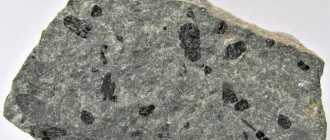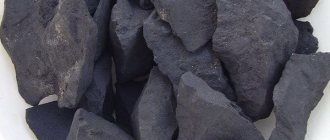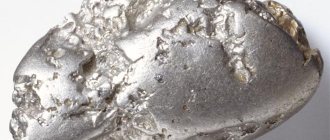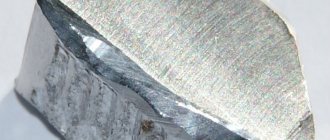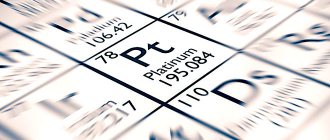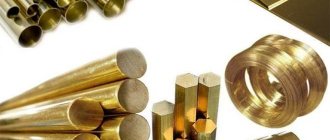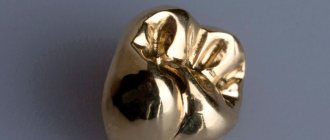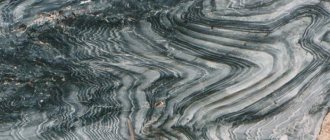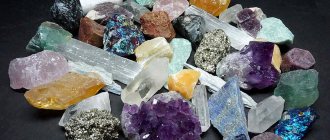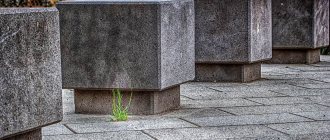The origin of the stone occurs during an amazing phenomenon - a volcanic eruption. Andesite carries many mysteries; some specimens are kept in museums and are recognized as an ancient relic. In addition to its widespread use in architecture and construction, there is an opinion that the stone is endowed with magical properties. Popular among adepts and esotericists.
In the article we learn the history, properties and areas of application of the useful and mysterious Andesite.
Origin
Like any rock, stone consists of a mixture of crushed minerals. Components of the stone: plagioclase, biotite, hornblende, feldspar and silica. It is worth noting that the balance of the composition always varies. Most often, there are rocks in which 50% is silicon oxide, and the remaining 50% is other compounds, but the percentage of silica varies from 30 to 70.
A sample of andesite (dark color) with amygdaloid bubbles filled with zeolites. Diameter - 6 cm.
The most common color of the stone is gray or close to black, but pink, red and burgundy shades are also found.
Andesite in chipped form is almost identical to Basalt - single-grained and close to homogeneity.
According to the mineralogical scale of hardness (Mohs scale), Andesite has 5 points. A high indicator for decorative products, maintaining strength for several centuries.
Formation of melts in island arcs[edit]
Andesite typically forms at the edges of converging plates, but can also occur in other tectonic settings. Magmatism in island arc regions occurs due to the interaction of the subducting plate and mantle wedge
, a wedge-shaped region between the subducting and dominant plates.
During subduction, the subducted oceanic crust is subjected to increasing pressure and temperature, resulting in metamorphism. Aqueous minerals such as amphibole, zeolites, chlorite, etc. (which are present in the oceanic lithosphere) dehydrate as they convert to more stable anhydrous forms, releasing water and soluble elements into the overlying mantle wedge. Fluxing water into the wedge lowers the solidus of the mantle material and causes partial melting. [13] Due to the lower density of the partially molten material, it rises through the wedge until it reaches the bottom of the overlapping plate. Melts generated in the mantle wedge have a basaltic composition, but they have a distinctive enrichment in soluble elements (e.g., potassium (K), barium (Ba), and lead (Pb)) that are contributed from sediments overlying the subducting slab. Although there is evidence that subducting oceanic crust may also melt during this process, the relative contributions of the three components (crust, sediment, and wedge) to the resulting basalts are still a matter of debate. [14]
The basalt thus formed may contribute to the formation of andesite through fractional crystallization, partial melting of the crust, or mixing of magma, all of which are discussed below.
Properties of the mineral Andesite
| Color | White, colorless, with a greenish, reddish tint. |
| Stroke color | White |
| origin of name | The name is given by the mountain system - the Andes, in which this mineral is abundantly present in lavas. |
| Chemical formula | Albit (70 - 50%) + anorthite (30 - 50%). |
| Shine | glass mother of pearl |
| Transparency | transparent translucent translucent |
| Cleavage | perfect on {001} average on {010} average on {110} |
| Kink | conchoidal |
| Hardness | 6 6,5 |
| Specific gravity | 2,66 |
| Selection form | Columnar, thick-tabular |
| Classes on taxonomy of the USSR | Silicates |
| singonia | triclinic |
| Fragility | Yes |
| Literature | Reference List: Richet, P. and Bottinga, Y. (1984b) Anorthite, andesine, wollastonite, diopside, cordierite, and pyrope thermodynamics of melting, glass transitions, and properties of the amorphous phases. Earth and Planetary Science Letters: 67: 415-432. |
See also[edit]
- Andesite Line
- List of Rock Types - A list of rock types recognized by geologists.
- Metamorphism is the change of minerals in pre-existing rocks without melting into liquid magma.
- Oceanic crust is the outermost layer of the oceanic part of a tectonic plate.
- The origin of granite is a common type of intrusive, felsic, igneous rock with a granular structure.
- Porphyry is a textural form of igneous rock with coarse-grained crystals in a fine matrix.
Mineral mining sites
Andesite is mined in quarries developed on mountain slopes.
Extraction occurs in three stages:
- Wells are drilled in the quarry into which explosives are placed. After a massive explosion, torn stones of varying sizes remain, and mostly still quite large. Next, another crushing occurs, also using blasting. And after that, the resulting stones are loaded onto dump trucks, which deliver them to processing plants.
- In factories, crushing tools get to work.
- The last stage is screening. Determines the size and shape of the resulting product or material.
Andesite quarries are located in Armenia, the Kuril Islands, Georgia, Ukraine, Kamchatka, the Caucasus, Crimea, Central Asia, and Primorye.
Mount Zharnov (Vtachnik), consisting of andesite.
Overseas, quarries and mines are located in France, Belgium and on the North American west coast.
ANDESITE and its characteristics.
CHAPTER 2
ENTERPRISES FOR THE PRODUCTION OF NON-ALLIED BUILDING MATERIALS
General definition of non-metallic building materials
Non-metallic building materials are natural stone materials obtained by mining dense and loose rocks.
In construction, these materials are widely used for the preparation of various types of concrete and mortars, in the manufacture of prefabricated reinforced concrete, for masonry and reinforced masonry, and also as ballast for railway tracks and road construction.
The group of non-metallic building materials includes:
- rubble stone - pieces of rock of irregular shape with dimensions in diameter of more than 150 mm;
— crushed stone is an artificial product obtained by crushing rocks, as well as a natural product, with pieces measuring 5–70 mm, and crushed stone up to 150 mm is sometimes used for the construction of massive concrete structures. Crushed stone has an irregular, acute-angled particle shape and a rough surface;
- gravel - mechanical deposits of rocks with grain sizes of 5-70 (150) mm, formed as a result of natural destruction (weathering) of rocks. Gravel grains have a more or less rounded shape and a smooth surface;
- sand - a natural or artificial loose mixture of grains with a particle size of 0.14 - 5 mm. Natural sands are formed as a result of the weathering of rocks. Artificial sands were formed as a result of crushing rocks. Sand grains, depending on the conditions of formation and methods of production, can have rounded or acute-angled shapes.
— clay is sedimentary rock composed of fine particles. The basis of clay is aqueous aluminosilicate minerals in the form of fine particles (<2 microns), and monomineral and polymineral clays are found. Clay minerals include kaolinite, a layered mineral of the composition Al2O3• 2SiO2 •2H2O, in clays it is present in the form of particles 0.3– 0.4 µm; montmorillonite is a layered mineral of the composition AI2O3 • 2SiO2 • 2H2O, in which in solid solution there is up to 5% Fe2O3, 4-9% MgO, up to 3.5% CaO, bentonite, halloysite, etc.
Clay rocks also include mudstones, loess, sandy loams and loams. Mudstones are hard rocks, a product of metamorphic transformation due to dehydration, compression and recrystallization of clays. Shales are rocks produced by the recrystallization of clays. Loess is an earthy rock composed of mica, kaolinite, feldspars, calcite, and quartz. Loam is a type of clay containing a significant amount of quartz (up to 40%). Clays also contain SiO2 in various forms (quartz, chalcedony, opal), iron oxides either in the form of solid solutions in aluminosilicates, or in the form of independent minerals (pyrite, magnetite, hematite, limonite).
Raw materials for the production of non-metallic building materials
To obtain non-metallic building materials, dense and loose rocks are used. Rocks are natural mineral aggregate formations in the earth's crust. Rocks can be composed of one or more minerals. Minerals are substances consisting of chemical compounds or chemical elements that are homogeneous in chemical composition and physical properties and have the same structure. The minerals that make up certain rocks are called rock-forming minerals.
According to the conditions of formation, rocks are divided into three groups: igneous (primary), sedimentary (secondary) and metamorphic (modified).
Igneous (primary) rocks were formed as a result of the cooling and solidification of magma of various chemical compositions. Depending on the conditions of formation, rate and cooling conditions, intrusive rocks, crystallized at different depths, erupted dense and erupted porous rocks are distinguished.
Deep (intrusive) rocks . They were formed at great depths with slow, uniform cooling of magma and high pressure. These conditions are favorable for crystallization processes. Such rocks have a granular-crystalline structure.
Deep rocks are characterized by high strength and density, low water absorption and high frost resistance. Depending on the
Based on the chemical composition of magma, the following deep-seated rocks are distinguished: granite, diorite, syenite, gabbro, basalt, etc.
The most common rocks are gabbro, basalts and granites , which occur in the form of large massifs and are distinguished by the constancy of their physical and mechanical properties and homogeneity.
GRANITES and its characteristics.
Granites (from the Latin granum - grain) are the most common deep-seated rocks with a pronounced granular-crystalline structure. The term “granite” was first used in literature by the Italian mineralogist Andrea Cesalpino in 1596 [1].
Fig.2.1 Granite sample
They consist of feldspars (usually 40...60%), quartz (20...40%), mica, ferromagnesian silicates - hornblende, amphiboles, less often pyroxenes (up to 10%). Based on the size of the grains, three granite structures are distinguished:
— fine-grained (up to 2 mm),
- medium-grained (from 2 to 5 mm),
— coarse-grained (over 5 mm).
Granite is usually well polished, maintaining a mirror surface in the outer cladding for a long time, and is easy to carve, acquiring various chipping textures. The relief textures of granite especially successfully emphasize the monumentality of structures; at the same time, an interesting decorative effect of the play of chiaroscuro on the surface of the stone is achieved, sometimes combined with the sparkles of mica plates. Some varieties of granites receive a highly decorative texture after heat treatment (this applies primarily to light gray rocks, which acquire a delicate, almost sugar-white hue).
Due to its high mechanical properties (axial compressive strength Rcom = 200...350 MPa) and operational properties, granites are widely used in construction in the form of facing slabs, architectural and construction products, cladding parts for hydraulic structures, bridge abutments, side stones, etc. .
Fig.2.2 Granite sample
Fine-grained homogeneous varieties of granite of light gray and pink colors are used as a sculptural material, taking into account the fact that their fine-grained structure allows impact processing without the formation of non-directional chips.
Fig.2.3 Texture and color of granites
Granites with a coarse-grained structure are successfully used for the construction of large monumental structures and for the cladding of pedestals for monuments. “No stone matches bronze as well as granite,” said the famous Russian sculptor B.I. Orlovsky.
The main areas of distribution of granites are in Ukraine, Russia, in particular in Karelia and the Urals, and Central Asia.
DIORITES and its characteristics.
Diorites are a mountainous igneous deep rock consisting of plagioclase with admixtures of a small amount of colored minerals, which in most cases is hornblende. The main deposits of diorite are located in the Cordillera (northwestern USA), Kazakhstan and Great Britain. On the territory of the Russian Federation, it is mined in the Ural Mountains and in Ukraine, in the Carpathians. [1]
The color of the stone has a greenish tint: brown-green, brown-green, dark emerald. There are also smoky, gray, ashy specimens. The color of this rock is slightly lighter in tone than that of gabbro. Diorite has extremely high viscosity, and accordingly, it is characterized by slight fragility. It is highly resistant to impact loads. The axial compressive strength of this rock is 155-280 MPa, Poisson's ratio is 0.3, and Young's modulus is 7.4 Pa. The density of the stone varies between 2725-2920 kg/m3.
Fig.2.4 Diorite sample
Kersanton, tonalite, hemitren, kersantite, paleophyre, banatite and other rocks are also considered varieties of diorite. The first name denotes the concept of mica-type diorites. The concept of tonalite originally denoted quartz varieties of this stone; at the moment, tonalite refers to rocks of a similar composition, which contain more than 20% quartz impurities. Paleophyre, or, as it is currently called, diorite porphyrite, is a holocrystalline stone, effusive or veiny, characterized by the presence of hornblende in its composition. Kersantite is only a vein stone; it is distinguished by the presence of biotite in its structure in combination with quartz and acidic plagioclase. [1]
SYENITE and its characteristics.
Syenite (from Syene - Siene, the Greek name of the ancient Egyptian city of Song, now Aswan * a. syenite, sienite; n. Suenit; f. syenit; i. sienita) is an intrusive holocrystalline rock, quartz-free, with a high content of alkali feldspars (60-90%) and dark-colored minerals (10-20%). In terms of silica content, syenite is classified as a medium-sized rock, differing from diorite in its higher alkali content. [1]
Based on alkalinity, syenites are divided into 3 groups: normal, high (subalkaline) alkalinity and alkaline. The former are composed of potassium feldspar, hornblende, biotite, pyroxenes (augite, diopside), and plagioclases (oligoclase or andesine) are present. The content of accessory minerals (apatite, sphene, zircon, magnetite, ilmenite) often reaches 5%.
Fig.2.5 Syenite sample
Subalkaline and alkaline syenites contain only alkali feldspars; alkaline amphiboles (barkevikite, riebeckite, arfwedsonite, hastingsite) and pyroxenes (aegirine, aegirine-augite) appear among dark-colored minerals. Nepheline syenites are classified as a separate group of feldspathoid rocks. Syenite also includes a group of vein melanocratic rocks - lamprophyres.
Density 2600-2750 kg/m3, compressive strength 150-300 MPa.
Syenites are used in construction as rubble and facing stone (deposits in Russia, Irkutsk region, Krasnoyarsk region).
GABBRO and its characteristics.
Gabbro (Italian gabbro) is an igneous intrusive rock of basic composition. The main minerals of gabbro are the main (rich in anorthite component) plagioclase and monoclinic pyroxene, sometimes also containing olivine, orthorhombic pyroxene, hornblende and quartz, apatite, ilmenite, magnetite, sphene, and sometimes chromite are present as accessory minerals. [1]
Color. Black, dark green, sometimes spotted breed.
Structure. Full-crystalline, uniformly crystalline, coarse- and medium-grained. Texture. Massive, sometimes spotted, banded. Average density - 2.9 - 3.1. Form of occurrence. Large laccoliths, lopoliths, sills and stocks.
Fig.2.6 Gabbro sample
Often found in layered differentiated intrusive complexes containing mafic and ultramafic rocks. In ophiolite complexes it forms tectonic plates. Layered, parallelepipedal. Genesis. Intrusive rock.
Place of Birth. Distributed in various regions of Great Britain, in North America (in the Adirondack Mountains) and along the coast of the Labrador Peninsula (Canada), in South Africa, France, Scotland (UK), etc.; large massifs of gabbro are known in Russia, in particular in the Urals and the Kola Peninsula, in Ukraine, in Transcaucasia, etc.
Practical significance. Gabbros sometimes contain accumulations of ore minerals and in these cases can be used as ores of copper, nickel, titanium and iron. Often used as building and facing stone of high strength, for external and internal cladding, mainly in the form of polished slabs and for the preparation of crushed stone and road stone. Gabbro is also very often used as tombstones (monuments, lining a burial site). Most often, gabbro from Ukrainian deposits is used for these purposes.
Varieties. Anorthosites are devoid of dark-colored minerals, norites are composed of plagioclase and orthorhombic pyroxenes, troctolites are composed of plagioclase and olivine.
ANORTHOSITE (from the French anorthose - plagioclase * a. anorthosite, plagioclasite, plagioclase rock; n. Anorthosit; f. anorthosite; i. anortosita) is a rock of the gabbro group, consisting mainly of calcium-rich calc-alkaline feldspar, usually labradorite (labradorite), less often andesite or bytownite with a small content (no more than 5-10%) of non-ferrous minerals (olivine, pyroxene, titanomagnetite, apatite, etc.). Color from white to dark gray, sometimes almost black varieties are found (due to the admixture of ilmenite and other fine ore minerals), average chemical composition of anorthosite (% by weight): SiO2 - 50.41; TiO2 - 0.18; Al2O3 - 27.75; Fe2O3 - 0.89; FeO - 1.61; MnO - 0.06; MgO - 1.54; CaO - 12.23; Na2O - 3.17; K2O - 0.86; H2O - 1.13; P2O5 - 0.17. Density of anorthosite 2710-3050 kg/m3, porosity 0.2-0.5%, water absorption 0.1-0.3%, resistance to axial compression 100-250 MPa.
There are stratiform anorthosites, found in the form of separate layers in differentiated massifs of different ages, and autonomous Precambrian anorthosites, composing large bodies (an area of several thousand km2) in the basement of ancient platforms. By age, anorthosites from the early stages of the Earth’s development are distinguished (2-4 billion years) and anorthosites from the stage of stabilization of ancient platforms (1.7-2 billion years). The latter form a giant anorthosite belt that frames the East European Platform from the west. Autonomous anorthosites are associated with gabbros, granulites, charnockites and rapakivi granites.
Anorthosites are one of the oldest known rocks in the earth's crust. In addition, analogues of terrestrial anorthosites were found on the Moon as part of lunar soil delivered to Earth. Anorthosite is believed to be one of the first products to crystallize in the Earth's crust; this served as the beginning of all further evolution of the rocks of the earth's crust. Anorthosite massifs are found in all areas of outcrops of ancient rocks. Outcrops of anorthosites are known on the Kola Peninsula, Ukraine, Latvia and Eastern Siberia, a huge massif is on the Dzhugdzhur ridge in Primorye.
If olivine is present in gabbro along with pyroxene, the rock is called olivine gabbro . Gabbros rich in plagioclase (85-90%) are classified as anorthosites. Of these, labradorites are known, the plagioclases of which often have a beautiful bluish or greenish play of colors. Gabbro containing significant amounts of olivine (>5%) is called olivine gabbro. If pyroxenes are practically absent, and the rock consists predominantly of plagioclase and olivine, then such gabbroids are usually called troctolites .
Extruded (effusive) dense rocks . They arose during the cooling of magma in the surface layer of the Earth’s crust, i.e. as a result of faster and less uniform cooling of the magma, they have a mixed (porphyry) structure. In most cases, they consist of crystals embedded in the main fine-grained or even glassy mass. The properties of dense extruded rocks are close to those of deep-seated rocks. These include: porphyry, andesite, basalt, etc. The most common rock is basalt (an effusive analogue of gabbro).
BASALT and its characteristics.
Basalt (Latin basaltes, basanites, from Greek basanos - touchstone; according to another version, from Ethiopian basal - iron-containing stone * English basalt, basaltic rocks; German Basalt; French basalte; Spanish basalto) - erupted cenotype basic rock, effusive analogue of gabbro. The color of basalt is dark to black. It consists mainly of basic plagioclase, monoclinic pyroxene, olivine, volcanic glass and accessory minerals - magnetite, ilmenite, apatite, etc. Basalt structures are intersertal, aphyric, less often hyalopilitic, textures are massive or porous, amygdaloid. Depending on the grain size, they are distinguished: the coarsest-grained is Dolerite, the fine-grained is anamesite, and the fine-grained is basalt itself. Paleotype analogues of basalt are diabases.
Average chemical composition of basalt according to P. Daly (%): SiO2 - 49.06; TiO2 - 1.36; Al2O3 - 15.70; Fe2 O3 - 5.38; FeO - 6.37; MgO - 6.17; CaO - 8.95; Na2O - 3.11; K2O - 1.52; MnO - 0.31; P2O5 - 0.45; H2O - 1.62. The SiO2 content in basalt ranges from 44 to 53.5%. According to the chemical and mineral composition, olivine basalts unsaturated with silica (SiO2 about 45%) and tholeiitic basalts without olivine or with an insignificant olivine content slightly saturated with silica (SiO2 about 50%) are distinguished. The physical and mechanical properties of basalt are very different, which is explained by different porosity. Basaltic magmas, having low viscosity, are easily mobile and are characterized by a variety of occurrence forms (covers, flows, dikes, strata deposits). Basalt is characterized by columnar, less often spherical, individuality. Olivine basalts are known on the ocean floor, oceanic islands (Hawaii) and are widely developed in folded belts. Tholeiitic basalts occupy vast areas on platforms (trap formations of Siberia, South America, India). The rocks of the trap formation are associated with deposits of iron, nickel, platinum, and Iceland spar ores (Siberia). A deposit of native copper is known in the amygdaloidal basaltic porphyrites of the Lake Superior region in the USA. [1]
Basalt density is 2520-2970 kg/m³. Porosity coefficient 0.6-19%, water absorption 0.15-10.2%, compressive strength 60-400 MPa, abrasion 1-20 kg/m², melting point 1100-1250°C, sometimes up to 1450°C, specific heat capacity 0.84 J/kg•K at 0°C, Young's modulus (6.2-11.3)•104 MPa, shear modulus (2.75-3.46)•104 MPa, Poisson's ratio 0.20-0 ,25. The high strength of basalt and the relatively low melting point have led to its use as a building stone and raw material for stone casting and mineral wool. Basalt is widely used to produce crushed stone, road (side and paving stones) and facing stones, acid- and alkali-resistant material. [1]
Fig.2.7 Basalt sample
To produce mineral wool, basalt is usually used in blending. It has been established that the melting point of the raw material should not exceed 1500°C, and the chemical composition of the melt is regulated by the following limits (%): SiO2 - 34-45, Al2O3 - 12-18, FeO up to 10, CaO - 22-30, MgO - 8- 14, MnO - 1-3. Basalt casting materials have great chemical resistance, hardness and abrasion resistance, high dielectricity and are used in the form of floor and cladding slabs, pipeline linings, cyclones, and also as various insulators.
In the CIS, 50 deposits with industrial reserves of 40 million m³ have been explored for crushed stone. Two basalt deposits with industrial reserves of 6.5 million m³ have been explored for facing stone (Armenia, Georgia). Annual basalt production is over 3 million m³. In the CIS, basalt deposits are concentrated mainly in Armenia, Russia, in particular in Eastern Siberia and the Far East. Basalt covers in the eastern regions of the United States form large deposits in the states of New York, New Jersey, Pennsylvania, Connecticut (the largest quarries and stone crushing plants).
ANDESITE and its characteristics.
Andesite (from the name of the Andes mountain range in South America * a. andesite; n. Andesit, f. andesite; i. andesita) is a cenotype rock, an effusive analogue of diorite. The color of andesite is from gray to black, sometimes with a green tint, the structure is porphyritic.
Fig.2.8 Andesite sample
Andesites are formed during the process of volcanic eruptions during the solidification of lava that reached the surface or remained in the bowels of the earth near the surface. The bulk of andesite consists of plagioclase microlites and minor amounts of pyroxene embedded in volcanic glass. Phenocrysts are represented by plagioclase, monoclinic or orthorhombic pyroxene, hornblende, and biotite. Olivine is occasionally present; the average chemical composition of andesite (% by weight) according to Daly: SiO2 - 59.59; TiO2 - 0.77; Al2O3 - 17.31; Fe2O2 - 3.33; FeO -3.13; MnO - 0.18; MgO - 2.75; CaO -5.80; Na2O - 3.53; K2O - 2.04; H2O - 1.26; P2O5 - 0.26. [1]
Andesite lavas usually contain a large amount of volatile components (water, carbon dioxide, hydrogen sulfide, etc.), which leads to catastrophic eruptions with explosions (Martinique Island, Krakatoa volcano). Andesite, together with basalts, is widespread in Russia, within modern island arcs (Kamchatka, Kuril Islands), as well as alpine orogenic belts in Ukraine (Carpathians, partly Crimea). Typically, andesites form sheets and lava flows, as well as extrusive forms such as domes and obelisks. Density 2280 - 2680 kg/m3, porosity 0.8-9.6%, less often up to 14%, compression resistance 80-240 MPa, softening coefficient 0.8-1.0. [1]
Fig.2.9 Andesite sample
It is used as crushed stone for concrete, in road construction (crushed stone, paving stones, bridge blocks), less often as an acid-resistant material and facing stone. In Russia, 21 andesite deposits have been explored for crushed stone with industrial reserves of about 250 million m3 (1976); andesitic porphyrite deposit (Akbastau, Kazakhstan) was explored for facing stone. In Ukraine, andesite deposits are concentrated mainly in the Transcarpathian region. One of the large deposits is Rokosovskoye (Transcarpathian region): reserves are 42.4 million m3, annual production is over 0.8 million m3 of crushed stone.
Abroad, large deposits of andesites are known on the west coast of the USA, France and Belgium.
Sedimentary secondary rocks were formed as a result of the destruction of igneous (primary) rocks and the subsequent deposition and accumulation of destruction products in the form of layers at the site of formation or during the transfer of water.
Sedimentary rocks include sand, gravel, crushed stone, clay, gypsum, dolomite, magnesite, diatomite, tripoli, chalk, and limestone. Sedimentary rocks are more diverse in composition, structure and physical and mechanical properties.
Of the sedimentary rocks for the production of non-metallic building materials, the most widely used are limestones, dolomites, sandstones, as well as loose sedimentary rocks: crushed stone, gravel and sand.
LIMESTONE and its characteristics.
Limestone (a. limestone; n. Kalkstein; f. calcaire; i. caliza) is a sedimentary carbonate rock consisting mainly of calcite or calcite skeletal remains of organisms, rarely of aragonite. The chemical composition of pure limestones is close to calcite, where CaO is 56% and CO2 is 44%. Limestone in some cases includes admixtures of clay minerals, dolomite, quartz, less often gypsum, pyrite and organic residues, which determine the name of limestone. Dolomitized limestone contains from 4 to 17% MgO, marly limestone - from 6 to 21% SiO2 + R2O3. The sandy and silicified limestone contains admixtures of quartz, opal and chalcedony. It is customary to reflect in the name of limestone the predominant presence of organogenic remains (bryozoan, algal), or its structure (crystalline, clotty, detritus), or the shape of rock-forming particles (oolitic, brecciform).
Fig. 2.10 Dense limestone in the form of crushed stone
Based on their structure, limestones are distinguished as crystalline, organogenic-clastic, detrital-crystalline (mixed structure) and sinter (travertine). Among crystalline limestones, based on the size of the grains, they are distinguished into coarse, fine, and cryptocrystalline (aphanitic), and based on the shine on the fracture - recrystallized (marble) and cavernous (travertine). Crystalline limestone is massive and dense, slightly porous; travertine - cavernous and highly porous.
Among the organogenic-clastic limestone, depending on the composition and size of the particles, they are distinguished: reef limestone; shell limestone (shell rock), consisting primarily of whole or crushed shells held together by carbonate, clay or other natural cement. Detritus limestone composed of shell fragments and other organogenic fragments cemented by calcite cement and algal limestone. [1]
Organogenic-clastic limestones also include white (so-called writing) chalk. Organogenic-clastic limestones are characterized by large porosity, low average density and are easy to process (sawn and polished).
Clastic-crystalline limestone consists of carbonate detritus of various shapes and sizes (lumps, clots and nodules of fine-grained calcite), with the inclusion of individual grains and fragments of various rocks and minerals, lenses of chert. Sometimes the limestone is composed of oolitic grains, the cores of which are represented by fragments of quartz and flint. They are characterized by small pores of different shapes, variable volumetric mass, low strength and high water absorption. Sinter limestone (travertine, calcareous tuff) consists of sinter calcite. It is characterized by cellularity, low average density, and is easy to process and saw.
Limestone is one of the most widespread sedimentary rocks; it composes various landforms of the Earth. Limestone deposits are found among sediments of all geological systems - from Precambrian to Quaternary; the most intensive formation of limestones occurred in the Silurian, Carboniferous, Jurassic and Upper Cretaceous; make up 19-22% of the total mass of sedimentary rocks. The thickness of the limestone strata is extremely variable: from a few centimeters (in individual layers of sediments) to 5000 m.
The physical and mechanical properties of limestone are extremely heterogeneous, but are directly dependent on their structure and texture. The density of limestone is 2700-2900 kg/m3, varies depending on the content of impurities of dolomite, quartz and other minerals. The volumetric mass of limestones varies from 800 kg/m3 (for shell rocks and travertine) to 2800 kg/m3 (for crystalline limestones). The compressive strength of limestone ranges from 0.4 MPa (for shell rock) to 300 MPa (for crystalline and aphanitic limestone). [1]
Limestone is the most important building material; it is used to make facing slabs, wall blocks, sculptural and architectural-building products, crushed stone for the production of concrete and asphalt concrete, railway ballast, road bases and surfaces, filters for hydraulic structures, as rubble stone for foundations, paving slopes, sides etc.
SANDSTONE and its characteristics.
Sandstone (a. sandstone; n. Sandstein; f. gres; i. arenisca) is a sedimentary rock consisting of sand grains cemented by clayey, carbonate, siliceous or other material (Fig.). According to the time of appearance, cementing substances can be syngenetic, i.e. deposited simultaneously with sand grains, and epigenetic, penetrating into the loose rock and filling the voids between the grains after a certain time after its deposition. According to the predominant grain size, sandstones are divided into fine-, fine-, medium-, coarse- and coarse-grained. Sandstones composed predominantly of grains of one mineral are called monomineral, two - oligomictic, and many - polymictic. The definition of sandstone usually includes cement composition. [1]
Fig.2.11 Sandstone samples
Sandstone can be of different colors, but the predominant color is grey, yellowish-gray or white, and less commonly reddish. Sandstone density 2250-2670 kg/m3; porosity 0.69-6.70%; water absorption 0.63-6.0%; compressive strength 30-266 MPa. Sandstone with siliceous and carbonate cementing substances has the best physical and mechanical properties, the worst - with clayey ones. During metamorphism, sandstone turns into quartzite. Quartz sandstones and quartzites have a fire resistance of 1700-1770°C.
DOLOMITE and its characteristics.
Dolomite (named after the French geologist D. Dolomieu, D. Dolomieu, 1750-1801 * a. dolomite; n. Dolomit, Dolomitmasse; f. dolomite, dolomie; i. dolomita) is a mineral of the carbonate class, a double carbonate salt of calcium and magnesium , CaMg(СО3)2. Contains 30.4% CaO; 21.8% MgO and 47.8% CO2. Mass ratio CaO/MgO = 1.39. May contain impurities Fe+2 and Mn+2, Co, Pb, Zn. The structure is island, trigonal system. Crystals are rhombohedral, prismatic, tabular. The aggregates are granular, kidney-shaped, porcelain-shaped with a conchoidal fracture, sometimes fibrous or in the form of pisolites. Coarse-crystalline aggregates occur in hydrothermal formations and recrystallized carbonate strata. The color is grayish-white, sometimes with a yellowish, brownish and greenish tint. Glass shine. Cleavage perfect along the rhombohedron. Hardness 3.5-4.0. Density 2850 g/m3. [1]
Fig.2.12 Dolomite sample
When using dolomites in construction, requirements are placed on its physical and mechanical properties. The average density of dolomite is from 2000-2800 kg/m3, porosity is from tens of a percent to 60% (by volume), the ultimate crushing strength in a dry state is from a few to 300 MPa (usually 20-80 MPa).
GRAVEL (from French gravier * a. gravel, grit; n. Kies; f. gravier; i. gravera) - loose sedimentary rock, consisting of more or less rounded rock fragments and (less often) various minerals with a diameter of 1 -10 mm; in mining, gravel with a size of 5-70 mm is distinguished.
Depending on the predominant sizes of fragments in geological classifications, gravel is divided into small (1-2.5 mm), medium (2.5-5 mm) and large (5-10 mm). In mining and construction, the following gravel fractions (mm) are distinguished by grain size: 5-10, 10-20, 20-40, 40-70.
Based on their origin, gravel is divided into river, lake, sea and fluvio-glacial. Gravel occurs in the basal horizons of alluvium of river terraces and floodplains, in fluvio-glacial deposits - kamas, eskers and in the coastal ramparts of sea coasts. Cemented gravel is called gravelite.
Fig.2.13 Gravel samples
CRUSHED STONE (a. rock debris, rock waste, crushed stone; n. Schotter, Steinschnitt; f. gravillon, granulats, pierre soncassee; i. cascajo, ripio) –
1) loose coarse-grained (psephitic) rock, consisting of almost unrounded acute-angled fragments of hard rock ranging in size from 10 to 100 mm. Based on the predominant size of the fragments, crushed stone is classified into large (70-150 mm), medium (20-70 mm) and small (10-20 mm).
2) Material in the form of pieces, usually of an acute-angled shape, ranging in size from 3 or 5 to 150 mm, obtained by crushing and subsequent sifting or sifting without crushing rocks, metallurgical slags and some heat-treated materials.[1]
Fig.2.14. Crushed stone samples
Crushed stone is divided into fractions (mm): 3-10 or 5-10, 10-20, 20-40, 40-70; At the request of consumers, it can be produced with grains larger than 70 mm. Crushed stone in the form of one or a mixture of two adjacent fractions is fractionated; when released without preliminary sieving into fractions or in the form of a mixture of more than two adjacent fractions, it is ordinary. When the crushed stone contains up to 15% of lamellar-shaped grains, the crushed stone is cuboid, from 15 to 25% - improved, from 25 to 35% - ordinary. Based on frost resistance, crushed stone is divided into 7 grades (from Mrz-15 to Mrz-300). The content of dust and clay particles is regulated from 1% for crushed stone from igneous and metamorphic rocks and up to 2-3% from sedimentary rocks. In this case, the clay content in the lumps should not exceed 0.25%. The content of grains of weak rocks with a compressive strength of up to 20 MPa should be no more than 5% in crushed stone grades 1000-1400, 10% in crushed stone grades 400-800 and up to 15% in crushed stone grades 200 and 300. Crushed stone is characterized by a strength grade, determined depending on its purpose. [1]
SANDS (a. sands; n. Sand; f. sables; i. arenas) - fine-clastic loose sedimentary rocks (or modern sediments). They consist of rolled and angular grains (grains of sand) of various minerals and rock fragments. According to the conditions of formation, sands can be fluvial, lacustrine, marine, fluvioglacial, eluvial, deluvial, proluvial and aeolian. There is no generally accepted classification based on the size of grains and fragments. Typically, sand grains are classified as grains ranging in size from 0.05 to 2 mm. According to the predominant grain size, sands are divided into fine-grained (0.05-0.1 mm), fine-grained (0.1-0.25 mm), medium-grained (0.25-0.5 mm), coarse-grained (0.5-1 .00 mm), coarse-grained (1-2 mm). [1]
Sands, especially river and lake sands, almost always contain an admixture of silt (silt), clay and organic particles. Based on their material composition, they distinguish between monomineral sands, consisting of grains of predominantly one mineral, oligomictic sands, composed of grains of 2-3 minerals with a predominance of one, and polymictic sands, consisting of grains of minerals and rocks of various compositions. The most common sands are quartz, arkose (quartz-feldspathic), glauconite-quartz, mica, etc. Mica, carbonates, gypsum, magnetite, ilmenite, zircon, etc. are common impurities. Sand grains are divided into rounded and rounded-angular according to their shape. and angular; according to the degree of roundness - rolled, semi-rounded and acute-angled; by the nature of the surface - into grains with smooth, uneven and rough surfaces.
Fig.2.15. River sand
Fig.2.16. Sea sand
Sand quality requirements are determined by state and industry standards or technical specifications. From the point of view of the quantity and quality of quartz sands used, they can be divided into 2 component groups: mass use and narrow purpose. The first includes sands used in the construction of roads and railways, for the production of concrete and mortars, in the production of silicate building materials, for thinning clays in the manufacture of coarse ceramics, roofing roll materials, in cement production, and for laying underground mine workings. The quality requirements for these sands are usually limited by the grain size, and only some consumers make additional requirements that are not stringent in terms of mineral and chemical composition. Sands of the second group are used in foundries (molding sands), in the production of refractories (dinas), porcelain and earthenware, glass, for locomotive sandboxes, as an abrasive material, for testing cements, water filtration, etc. [1]
Types of stone
Mineralogists have identified the following types of Andesite:
- basaltic;
- albite;
- quartz;
- quartz-mixed;
- nepheline;
- leucite;
- xenolithic.
The most used type is nepheline. This type of mineral raw material is used in various fields of application. The highly alkaline properties of nepheline make it possible to use it in the leather, textile and woodworking industries. And the same variety, but with a small amount of dark-colored minerals, is used in ceramic and glass production. The high percentage of potassium in the composition perfectly oxidizes the soil and allows the use of nepheline Andesite in the production of fertilizers.
Various types of andesite
Due to its durability and external aesthetics, it is suitable for facing materials and is used in construction and finishing works.
Nepheline is rich in aluminum. The oxide content of this metal in the stone reaches 23%.
Description of the rock
Andesite is a volcanic rock born in magma, having an average composition, normal alkalinity. Belongs to the geological family of andesites.
The composition of the mineral rock up to 70% includes:
- inclusions of feldspars,
- Augites,
- hornblende,
- biotype,
- plagioclase,
- Olivine can occasionally be found.
Accordingly, the names of andesite will be: hornblende, pyroxene, plagioclase or biotite. The basis of this stone is silica (silicon dioxide). It gives such strength. On the hardness scale, the stone has 5 units.
A common stone is an effusive analogue of quartz diorite , the color of which ranges from gray to almost black. Sometimes there is a green, yellow and even red tint. The color of the breed is heterogeneous: stains, “drizzle”, waves of color.
The structure of the rock is incompletely crystalline , pilotaxitic, fine-grained, rough to the touch. The texture is often fluid, dense and porous, bubbly, very rarely glassy. Under a microscope it is clearly visible that the texture and composition of the rocks are close to andesite: basalts, dacites, trachytes.
The main features by which andesites can be distinguished from basalts under a microscope:
- The volume of femic minerals is up to 30% (in basalts – 50%);
- The phenocrysts contain more plagioclase than minerals;
- Presence of basaltic hornblende and biotype;
- Presence of microliths;
- Hyapopilitic and pilotaxitic structure.
Scope of application
The scope of application of the stone is quite wide:
- It is used as an acid-resistant material, which allows the production of high-class glass.
- For the production of crushed stone and concrete products. Crushed stone made from andesite has a number of advantages: resistance to various weather disasters, highest strength, etc.
Construction crushed stone is actively gaining momentum in various fields. It is used in road construction for paving sidewalks, constructing foundations, and manufacturing concrete products.
- Making black porcelain.
- Material for lining acid production facilities. And also for lining construction refrigerators, settling tanks and towers.
- Tabletops and all kinds of crafts, such as souvenir eggs, boxes, and vases, are carved from stone.
- Andesite sanitary ware is increasingly valued, as it does not require special care, is durable and environmentally friendly.
Physico-chemical characteristics
For a chemist, the mineral andesite is a compound of complex composition with a long formula.
The main characteristics of the rock are strength, resistance to heat, temperature changes, acids, alkalis, and other chemicals. Sometimes it is decorative.
A sample of andesite (dark color) with amygdaloid bubbles filled with zeolites. Diameter - 6 cm.
Excess moisture provokes oxidation of iron, which is why the gray-black agglomerates turn brown or pink.
Average chemical composition: SiO2 56-64%, TiO2 0.5-0.7%, Al2O3 16-21%, Fe2O3 3-4%, FeO 3-5%, MgO 3-4%, CaO 6-7%, Na2O 2-4 %, K2O 1-2%.
Price
In Russia, fragmentation Andesite is valued quite low, from 500 to 1 thousand rubles per ton. The low price is set due to the fact that most often they sell fragments that are not suitable for the production of furniture and building boards.
But the cost of finished products made from this stone is very high. For example, a sink made from a solid boulder will cost about 40 thousand rubles.
Round countertop washbasin made of andesite.
Usage
As a crafting ingredient
| Ingredients | Crafting recipes | Result |
| Andesite | 6 | Andesite wall |
| Andesite or Polished Andesite | 66 | Andesite Slab or Polished Andesite Slab |
| Andesite or Polished Andesite | 44 | Andesite steps or Polished andesite steps |
Magical properties of andesite
It is interesting that the stone appears among the mysteries of civilization.
In 1961, on the banks of the Ica River, professional archaeologists actively mined gold and various ancient treasures. They discovered a huge amount of black Andesite stones with images of scenes of life of the Indians who previously inhabited these lands. The bulk of the images were enigmatic and mysterious: organ transplant operations, detailed maps of unknown continents, prehistoric animals, flying machines of frightening designs.
The stones were not immediately handed over to scientists and went on sale on the black market in Peru.
Brothers Pablo and Carlos Soldi were the first to acquire the mysterious Andesites. They immediately began to attract the attention of scientific archaeologists, and were even ready to sponsor a project to study the found relic, but everything was unsuccessful. And only a professor of medicine and a direct descendant of the founders of the city of Ica was able to begin the study of stones.
It has been established that the Ica stones were buried in water immediately after they were made.
Scientists are skeptical about everything related to the study of Ica stones. But still, these relics make us think about what the planet was like in the past? Many writers are inclined to believe that the stones are related to the mysterious Atlantis.
In modern society, sorcerers, healers and adherents of the occult began to make money with the help of stone. At the end of the twentieth century, Andesite suddenly began to cure unconsciousness and absent-mindedness, and some particularly powerful sorcerers assured that with the help of the stone it was possible to get rid of schizophrenia and insanity, and gain magical intuition and gifts.
Interestingly, stone-paved roads and streets have a low accident rate compared to granite or asphalt pavements. But the point is not at all about magic, and not about the stone’s ability to increase driver attentiveness. Andesite has a high ability to grip rubber - and in any weather, for example, in strong winds and rain.
Healing and magic
Andesite suddenly became a source of mysterious material even for occult practitioners when making Ica stones. , sorcerers, magicians and healers actively began to treat ailments with andesite: absent-mindedness and lack of magical intuition.
The stone protects against injuries, even mental ones, magicians say, awakening intuition in a person. Andesite is a stone that allows for grounding and focus. Through this stone, a person comes to peace and insight, moving away from outdated thoughts and outdated attitudes, gaining the opportunity to look inside himself at future goals and images in self-awareness.
Andesite opens up access to communication between the element of reason and the phenomenon of intuition. Treats flaws on a physical and psychological level, prompting an accurate understanding of the roots of what is happening and methods of healing.
Even skin, bones and muscles switch to healthy functioning when interacting with andesite.
Interesting things about the stone
- Home interior items made from solid Andesite boulders (countertops, sanitary ware, vases), with imitations of drawings on ancient Ica stones cost about 70 thousand rubles. Despite the skepticism of scientists, real Ica stones are prohibited from production and trade.
- It is believed that Andesite helps heal physical and psychological injuries and disorders. Helps to find calm in a panic state. Small stone fragments are used as pocket and car amulets.
- Often, the accumulation of Andesites is the cause of a large-scale volcanic eruption, due to the fact that the stones clog the lava channels.
- During the stone extraction process, workers, if necessary, go through several stages of blasting Andesite wells in order to preserve the large size of the slabs. Subsequently they are used for the foundations of impressive buildings.
The ancient volcanic rock of these stones not only benefits humanity, as its composition is well applicable to many areas and industries, but also contains secrets of the past of our planet, the answers to which may still be ahead.
Story
The rock is relatively young: samples found in the Andes (mountain system of South America) were described in 1836 by geologist Christian Buch.
In history, andesite is associated with the civilization of the ancient Incas. The proof was the discovery of several stones by archaeologists. They depict moments of everyday life, battles, and other aspects of the daily life of the Indians.
The artifacts were divided among scientists and collectors.
Andesite is named after the Andes mountain range where the first samples of the rock were found.
Values
Block ID
Java Edition:
| Name | Identifier |
| Andesite | andesite |
| Polished andesite | polished_andesite |
Bedrock Edition and Java Edition 1.12:
| Name | Identifier | Numeric ID |
| Andesite | stone | 1 |
Data numbering
Main article: Data numbering
| Description | |
| 0 | Stone |
| 1 | Granite |
| 2 | Polished granite |
| 3 | Diorite |
| 4 | Polished diorite |
| 5 | Andesite |
| 6 | Polished andesite |
Block states
Minecraft:stone block states
| Name | Meaning | Description |
| variant | stone | Stone |
| granite | Granite | |
| polished_granite | Polished granite | |
| diorite | Diorite | |
| polished_diorite | Polished diorite | |
| andesite | Andesite | |
| polished_andesite | Polished andesite |
[until 1.13
]
